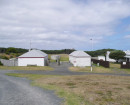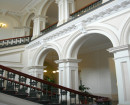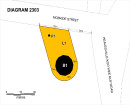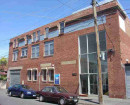Back to search results
AULD REEKIE
509-513 ROYAL PARADE PARKVILLE, MELBOURNE CITY
AULD REEKIE
509-513 ROYAL PARADE PARKVILLE, MELBOURNE CITY
All information on this page is maintained by Heritage Victoria.
Click below for their website and contact details.
Victorian Heritage Register
-
Add to tour
You must log in to do that.
-
Share
-
Shortlist place
You must log in to do that.
- Download report
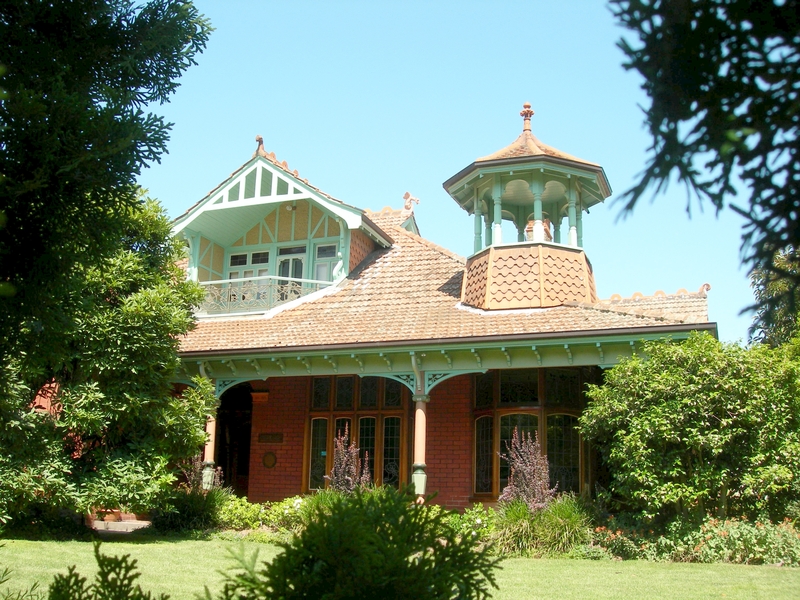
AULD REEKIE SOHE 2008


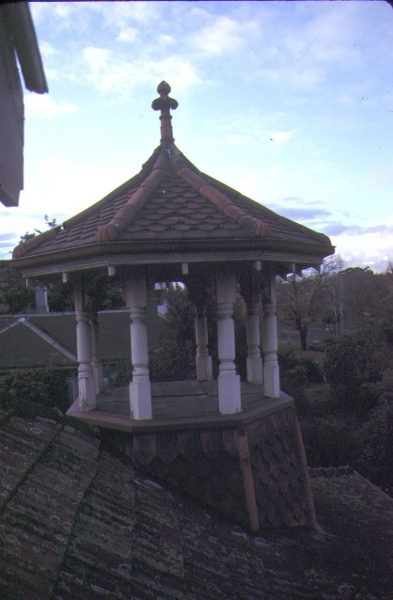
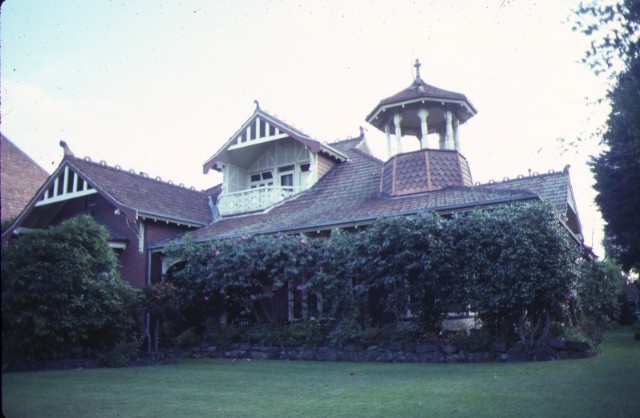

On this page:
Statement of Significance
What is significant?
The house known as 'Auld Reekie at 511 Royal Parade in Parkville dates from 1910, but possibly incorporates an earlier six roomed villa named 'May Day/ which had been built in 1872 by a butcher called Henry Harper. 'Auld Reekie' was constructed by Alexander and Jessie Sturrock who purchased the site in 1908. 'Auld Reekie' is built from red brick with a hipped-gable Marseilles tile roof decorated by tall chimneys, terra cotta chimney pots, ridging, scroll and dragon finials. The belvedere, attic with balcony and verandah complete the picturesque composition.
Internally the entrance hall is hexagonal with five rooms radiating outwards. Throughout the five front rooms all the joinery and fittings are original including lead lighting to many of the windows. The ceiling in the sitting room is hand painted with Art Nouveau foliated relief work. The hall has intact blackwood joinery with elaborate door surrounds and fluted pilasters and carved pedimental motifs. The floor is divided into marble squares.
The first floor verandah has an iron balustrade featuring a gum leaf pattern. The front fence is a iron palisade, with scroll shaped picket finials. The fence is set on a plinth of rusticated bluestone blocks. There is an off centre gateway, the metal gate in the shape of a shield, which is flanked by pink and white marble castellated octagonal posts with relief carving to each panel. The marble was imported from Italy. The other posts supporting the palisade are a smooth sided bollard shape with domed tops.
How is it significant?
'Auld Reekie' is of architectural significance to the State of Victoria.
Why is it significant?
'Auld Reekie' is architecturally significant as intact example of an Edwardian era villa in the so-called Federation Queen Anne style. This style, arguably one of the first distinctive Australian architectural styles, is illustrated by the elaborate roof detailing, picturesque appearance and materials of red brick and terra cotta tiles. The belvedere to 'Auld Reekie' and the first floor balcony with gum leaf pattern balustrading are significant, unusual and distinctive features of the style. The intact interiors with original decoration add to the stylistic importance of the building. The distinctive fence of marble pillars and iron palisade is highly unusual as timber fences were more usual during the Federation period.
'Auld Reekie' is the last surviving intact grand private residence in north Parkville.
The house is unusual in that it is one of the few to have survived intact in Parkville as a large private residence in its original extensive and attractive garden setting. It is significant that the pedestrian-only entrance remains and that all vehicular access is still from the rear. The front garden remains intact and forms a unifying element between fence and house.
The house known as 'Auld Reekie at 511 Royal Parade in Parkville dates from 1910, but possibly incorporates an earlier six roomed villa named 'May Day/ which had been built in 1872 by a butcher called Henry Harper. 'Auld Reekie' was constructed by Alexander and Jessie Sturrock who purchased the site in 1908. 'Auld Reekie' is built from red brick with a hipped-gable Marseilles tile roof decorated by tall chimneys, terra cotta chimney pots, ridging, scroll and dragon finials. The belvedere, attic with balcony and verandah complete the picturesque composition.
Internally the entrance hall is hexagonal with five rooms radiating outwards. Throughout the five front rooms all the joinery and fittings are original including lead lighting to many of the windows. The ceiling in the sitting room is hand painted with Art Nouveau foliated relief work. The hall has intact blackwood joinery with elaborate door surrounds and fluted pilasters and carved pedimental motifs. The floor is divided into marble squares.
The first floor verandah has an iron balustrade featuring a gum leaf pattern. The front fence is a iron palisade, with scroll shaped picket finials. The fence is set on a plinth of rusticated bluestone blocks. There is an off centre gateway, the metal gate in the shape of a shield, which is flanked by pink and white marble castellated octagonal posts with relief carving to each panel. The marble was imported from Italy. The other posts supporting the palisade are a smooth sided bollard shape with domed tops.
How is it significant?
'Auld Reekie' is of architectural significance to the State of Victoria.
Why is it significant?
'Auld Reekie' is architecturally significant as intact example of an Edwardian era villa in the so-called Federation Queen Anne style. This style, arguably one of the first distinctive Australian architectural styles, is illustrated by the elaborate roof detailing, picturesque appearance and materials of red brick and terra cotta tiles. The belvedere to 'Auld Reekie' and the first floor balcony with gum leaf pattern balustrading are significant, unusual and distinctive features of the style. The intact interiors with original decoration add to the stylistic importance of the building. The distinctive fence of marble pillars and iron palisade is highly unusual as timber fences were more usual during the Federation period.
'Auld Reekie' is the last surviving intact grand private residence in north Parkville.
The house is unusual in that it is one of the few to have survived intact in Parkville as a large private residence in its original extensive and attractive garden setting. It is significant that the pedestrian-only entrance remains and that all vehicular access is still from the rear. The front garden remains intact and forms a unifying element between fence and house.
Show more
Show less
-
-
AULD REEKIE - History
Associated People:
AULD REEKIE - Permit Exemptions
General Exemptions:General exemptions apply to all places and objects included in the Victorian Heritage Register (VHR). General exemptions have been designed to allow everyday activities, maintenance and changes to your property, which don’t harm its cultural heritage significance, to proceed without the need to obtain approvals under the Heritage Act 2017.Places of worship: In some circumstances, you can alter a place of worship to accommodate religious practices without a permit, but you must notify the Executive Director of Heritage Victoria before you start the works or activities at least 20 business days before the works or activities are to commence.Subdivision/consolidation: Permit exemptions exist for some subdivisions and consolidations. If the subdivision or consolidation is in accordance with a planning permit granted under Part 4 of the Planning and Environment Act 1987 and the application for the planning permit was referred to the Executive Director of Heritage Victoria as a determining referral authority, a permit is not required.Specific exemptions may also apply to your registered place or object. If applicable, these are listed below. Specific exemptions are tailored to the conservation and management needs of an individual registered place or object and set out works and activities that are exempt from the requirements of a permit. Specific exemptions prevail if they conflict with general exemptions. Find out more about heritage permit exemptions here.
-
-
-
-
-
IRON HOUSE
 Victorian Heritage Register H0665
Victorian Heritage Register H0665 -
CHRIST CHURCH
 Victorian Heritage Register H0129
Victorian Heritage Register H0129 -
TERRACE
 Victorian Heritage Register H0076
Victorian Heritage Register H0076
-
"1890"
 Yarra City
Yarra City -
"AMF Officers" Shed
 Moorabool Shire
Moorabool Shire -
"AQUA PROFONDA" SIGN, FITZROY POOL
 Victorian Heritage Register H1687
Victorian Heritage Register H1687
-
'Boonderoo', House and Outbuildings
 Greater Bendigo City
Greater Bendigo City -
'Riverslea' house
 Greater Bendigo City
Greater Bendigo City -
1 Adam Street
 Yarra City
Yarra City
-
-









